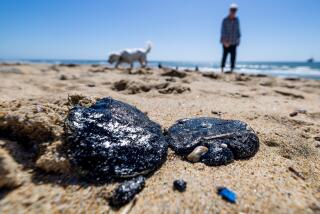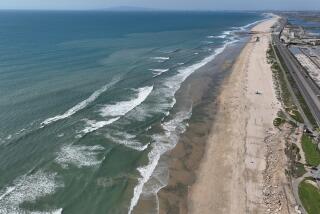Barrier Breaks; Oil Gets Into Wetlands
- Share via
After work crews battled the elements for 2 1/2 weeks to keep oil from getting into a sensitive wildlife preserve, pounding surf and high tides ruptured a protective dam and sent oil residue from the Feb. 7 tanker spill into the Huntington Beach Wetlands, officials said.
Although the amount of oil that invaded the Talbert Marsh area of the wetlands was in dispute Sunday, it was generally agreed among officials that the marsh could suffer long-term environmental consequences.
Huntington Beach Mayor Tom Mays said late Sunday that most of the oil washed back to sea with the tide and all that remained was about 10 gallons, spread in a six-foot-wide sheen along the length of the 25-acre marsh.
“We have been very fortunate,” said Mays, who made his estimate after a helicopter tour.
Still, he said, “any spill occurring in a wetlands is sensitive.”
But Victor Leipzig, a Huntington Beach city planner and coordinator of the spill’s volunteer rescue effort, disagreed, saying that there was a sheen of oil throughout the saltwater marsh.
“My guess is it has to be a lot more than 10 gallons,” he said. “There’s still a lot of oil in the wetlands. All seven islands in the wetlands were surrounded by bathtub-like oil rings. My assessment is there is a real problem.”
The Huntington Beach Wetlands, near the Santa Ana River mouth, are part of the Pacific flyway. The area is a refuge for migratory waterfowl and contains a number of endangered species.
Contamination of the marsh, in fact, was a worst-case scenario for officials, who had set up earthen dams, sandbags and a series of containment booms in recent weeks not only to protect the Huntington Beach Wetlands but the Bolsa Chica Wetlands and a marshy preserve in Upper Newport Bay. Unlike a beach, where oil eventually can be removed, the crude can permeate a wetlands so deeply that it may take months and even years to be cleaned, Leipzig said.
Efforts to protect the preserve had been largely successful until shortly before 9 a.m. Sunday, when a six-foot tide strengthened by seven-foot waves created a tidal surge that raced up the Talbert Channel leading to the Huntington Beach Wetlands.
The onslaught destroyed an eight-foot earthen dike that had been reinforced by hundreds of sandbags. A dozen absorbent booms placed on both sides of the dike were also shoved aside.
After the dike broke, officials said water struck the barriers, situated about 200 yards inland and just north of the river. The earthen dam collapsed in full view of scores of workers who were cleaning rocks in the channel.
Work crews late Sunday hastened to restore the berm, but Huntington Beach Fire Chief Ray Picard said untold damage already had been done.
While no exact assessment has been made of the total crude that invaded the marsh, Picard said early estimates were that mousse-like globs of brown oil had covered 5% of the Talbert Marsh area of the Huntington Beach Wetlands, while an oily sheen was seen over much of the rest of the preserve before tides pulled it back to sea.
“It’s a severe blow,” Picard said. “From an environmental standpoint, this is the worst that has happened since the spill.”
“So far, there is no evidence of any tremendous destruction of wildlife yet,” Leipzig added. But “from a cleanup point of view, there is no cleaning of oil from vegetation.”
Officials of British Petroleum, owners of the 394,000 gallons of Alaskan crude that spilled from the tanker American Trader off Huntington Beach, said Sunday that tests were being performed on the oil to determine if it is, in fact, from the vessel.
Company officials said the oil could have come from upstream runoff.
“There is some concern that this (oil) may have been from an upstream source,” British Petroleum spokeswoman Marcia Meermans said. “Nonetheless, we have people on scene.”
But both environmentalists at the scene and city officials said the oil appeared to be from the spill.
“Of course it’s possible the oil came from upstream, but I’m extremely skeptical,” Leipzig said. “I think the volume of oil in the marsh is indicative that it came from a major source.”
British Petroleum officials could not estimate Sunday how long it would take to clean up the latest mess.
“It will put us a little behind schedule,” Meermans said.
The petroleum company had been in what it described as its final mop-up of the Orange County coastline with the goal of reopening to the public 10 miles of beaches closed between Huntington Beach and Newport Beach. There was no indication Sunday when that might be.
Times correspondents Len Hall and Tom McQueeney contributed to this story.
More to Read
Sign up for Essential California
The most important California stories and recommendations in your inbox every morning.
You may occasionally receive promotional content from the Los Angeles Times.










